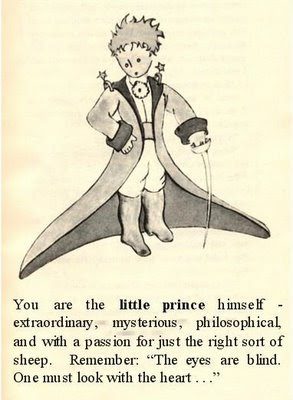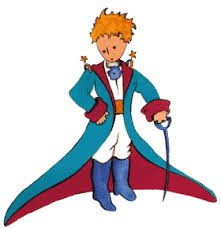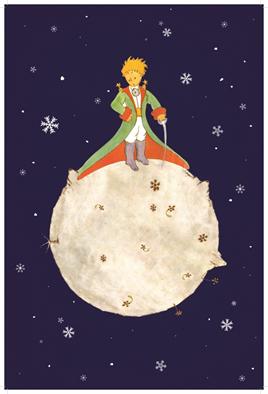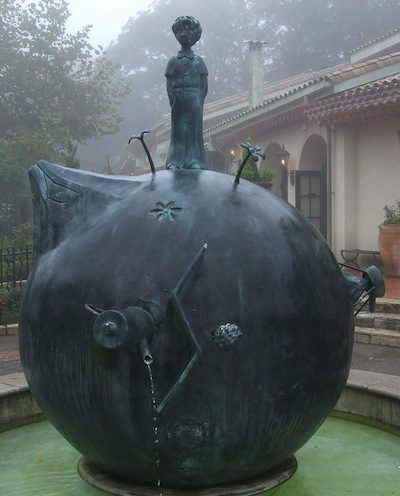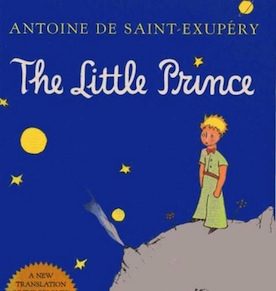
For as long as I can remember, I’ve been obsessed with a most extraordinary little boy. A boy who laughs, has golden hair, and refuses to answer questions. You know who I mean.
My obsession has made me into a thief, a collector, and a bit of a stalker. In third grade, I stole a copy of The Little Prince from my school library; the slip on its back cover reads “Date Due: Aug ’96.” After high school, I started seeking out editions in various languages—Hebrew, Spanish, Arabic—plus biographies of the author, Antoine de Saint-Exupéry, and plays and novels about his life. By the time I reached grad school, I was staying up late into the night, hunched over my laptop, researching, trying to track down the answer to a question that had gripped my imagination and refused to let me go: The real-life boy who inspired the character of the little prince—who was he, and where could I find him?
Internet research yielded three different possibilities. The first was a Parisian politician named Pierre Sudreau. As a 12-year-old boy, Sudreau had coped with the misery of boarding school by escaping into Saint-Ex’s books, and he wrote to the author to tell him that. The two struck up a correspondence that moved them both deeply. The articles I skimmed cited Sudreau’s boyhood friendship with the writer as proof that the prince was based on him. I looked closer. Not articles. Obituaries. Sudreau had died just a few months earlier. My heart sank.
Luckily, I found a second candidate in Land Morrow Lindbergh, son of famous New York aviator Charles Lindbergh. Saint-Ex had visited the Lindbergh home in 1939, with the goal of convincing his fellow pilot—who might, in turn, convince the Americans—to enter the war against Nazi Germany. Instead the author found himself captivated by Charles’s golden-haired boy; soon after, he wrote The Little Prince. Yet Land, today a 76-year-old Montana rancher, couldn’t be reached, no matter how many phone numbers I tried.
The third candidate was Thomas De Koninck. Google told me he was a philosophy professor in Québec. As a philosophy major who hails from Québec, I felt a shiver of excitement. I learned that Saint-Ex had stayed at the De Koninck house in 1942, where he met Thomas, then a precocious eight-year-old with curly blonde hair. I leaned over my keyboard, clicking and scrolling, until I found his name on Laval University’s faculty webpage. That site confirmed not only that he was still alive, but that he could easily be reached at the email address provided. I dashed off an email to him, requesting an interview, and fell asleep.
My obsession with The Little Prince started when my dad pressed his French-language edition into my nine-year-old hands. Opening the paperback, I saw that he had penciled in footnotes at the bottom of each page, noting the meaning of words he’d had to look up in his dictionary. One jumped out at me: apprivoiser, to tame. He had used this book to teach himself French, I realized. And, growing up in Montreal, I began to do the same.
So it seemed only natural that, as I moved from city to city to city, I would use this same book to learn the language of whatever new place I found myself in. When I landed in Jerusalem, my first move was not to pick up one of the free tourist maps on offer, but to buy a Hebrew-language copy of The Little Prince from the airport bookstore.
The book also oriented me in other ways: I used it to suss out people in my new surroundings. In Vancouver, on the graph paper of a schoolmate’s notebook, I drew what looked like an old-fashioned hat. When he thanked me for my picture of a boa constrictor digesting an elephant, I smiled at him, knowing we’d get along.
Later, when I started dating a girl who had never read The Little Prince, I gave her the book as a gift. “To you, I am nothing more than a fox like a hundred thousand other foxes,” I read to her in her apartment. “But if you tame me, then we shall need each other. To me, you will be unique in all the world. Please—tame me!” She took the hint and kissed me.
The more I researched, the more I realized that I was not the only one who felt a special sense of ownership over The Little Prince: Not just individual readers but entire cities had tried to make the book their own. Pierre Sudreau, Thomas De Koninck, and Land Morrow Lindbergh had all been co-opted by their respective hometowns, each of which claimed the book as part of its regional mythology.
The Parisian papers, in their obituaries for Sudreau, seemed less interested in eulogizing the dead man than in emphasizing his boyhood correspondence with Saint-Ex—a fellow Frenchman—and in situating The Little Prince as a distinctly French creation. They took it for granted that the prince was based on Sudreau, glossing over the fact that the book was written years later in New York and that it was published there two years before it ever saw the light of day in France.
As for Québec, in 1999 the local government had an official plaque mounted on De Koninck’s house. Under the words “the people of Québec remember,” it said: “Here sojourned—in 1942, with the De Koninck family—Antoine de Saint-Exupéry, author of The Little Prince.” Featuring the province’s iconic fleur-de-lys, the plaque’s implicit message was clear: It was the De Koninck boy who had inspired the prince; the book was basically Québecois. That message was backed up by a local legend: Apparently Saint-Ex had told De Koninck’s father—in a letter that was, sadly, lost—that he completed his portrait of the prince while drawing inspiration from Thomas.
And then, of course, there was New York City. The place I now call home was equally convinced that Saint-Ex and his prince were native New Yorkers. In a 1989 New York Times article, a guide offering a walking tour of Saint-Ex’s favorite haunts suggested that the author saw “the prototype of the Little Prince in the Lindberghs’ young, golden-haired son Land” before asserting, “He’s a New York author, crazy as it sounds.”
This spring, Manhattan’s Morgan Library & Museum took pains to back up this claim in an exhibit called “The Little Prince: A New York Story.” Its stated goal was to focus on “the story’s American origins.” It noted that Saint-Ex cited New York, Manhattan, or Long Island six times in his draft of The Little Prince. And that he mentioned New York landmarks like Rockefeller Center. And that his New York editor’s wife was the one who recommended he write a children’s book. And that the Dictaphone he used to revise the book was bought for $683 in, you guessed it, New York.
When it finally came time for my phone interview with Thomas De Koninck, I was almost painfully excited. The philosopher, speaking in a mix of English and French, began by telling me about Saint-Ex’s stay with his family in 1942.
“I recall his visit quite well,” De Koninck said, “because he was l’Aviateur, the Pilot—he was a hero for us. He made us paper planes, showed us drawings. We had other guests, but he was much closer to us, the children, than to the other people. He seemed bored with the adults.”
I smiled. That sounded like Saint-Ex, all right. Then the philosopher said something that made my heart skip a beat.
“I used to ask a lot of questions, as a child. He would listen and pay attention to them, and try to answer as best he could.”
I thought, then, of a certain little boy who was always asking questions but refusing to answer them. I asked De Koninck straight out: “What do you think of the local legend that you were Saint-Ex’s inspiration for the prince?”
“Well, he may have been stimulated by me,” he mused. “I did ask those questions, and there’s a coincidence in time there. I mean, it was the year before the book came out in New York.”
Now I was really excited. “And the letter that Saint-Ex wrote to your father, confirming that he based the prince on you—do you have any memory of that?”
“I have heard this often, but I have never seen that letter myself,” he said. “I haven’t been able to verify that.”
“Oh,” I said, feeling a bit deflated.
Casually, De Koninck added, “Anyway, I have always answered that to me, le petit prince is Saint-Exupéry himself. This comes from him, from his own experience of being a human being. Now, he may have drawn inspiration from children whom he met…”
He cited a passage I hadn’t heard of—something about le Mozart assassiné. A quick Google search told me it was something Saint-Ex had written on a train. I brought it up on my screen:
I sat down [facing a sleeping] couple. Between the man and the woman a child had hollowed himself out a place and fallen asleep. He turned in his slumber, and in the dim lamplight I saw his face. What an adorable face! A golden fruit had been born of these two peasants… This is a musician’s face, I told myself. This is the child Mozart. Little princes in legends are not different from this. Protected, sheltered, cultivated, what could not this child become? When by mutation a new rose is born in a garden, all gardeners rejoice. They isolate the rose, tend it, foster it. But there is no gardener for men. This little Mozart will be shaped like the rest by the common stamping machine… This little Mozart is condemned.
I stared at the passage. It mentioned a golden little prince, a rose in need of shelter—and it was written in 1935. Seven years before Saint-Ex ever met De Koninck.
I felt gutted. All along, I’d known that the prince bore some resemblance to the young Saint-Ex—as a kid, he’d been called le Roi-Soleil (the Sun King) thanks to his golden curls. But, having embarked on my treasure hunt, obsessed with finding the prince’s real-life inspiration, I hadn’t wanted to consider that he might be just an amalgam of random kids—the sons of friends, a sleeping boy on a train—with a little bit of Saint-Ex thrown in.
I’d wanted a boa constrictor digesting an elephant. Instead, I’d found a hat.
Why was I so disappointed?
For weeks afterward, I asked myself this question—though only intermittently. It was a busy time for me: grad school was wrapping up, and I was getting ready to move to a new city again.
Then, paging through the book, past the prince’s visits to various planets, I found the part where he tells the pilot not to be sad about his impending departure. “It’s too small, where I live, for me to show you where my star is. It’s better that way. My star will be… one of the stars, for you. So you’ll like looking at all of them.” He laughs, then says, “You’ll have stars that can laugh!”
That’s when I realized how badly I’d misunderstood the little prince—and how misguided my hunt for him had been. All these years, I’d been projecting my search for the perfect home onto this fictional boy, assuming he had to have one true source—one real-life person in one real-life place that gave rise to him in the author’s mind, and to which I could trace him back. But like Saint-Ex, the prince was a wanderer, impossible to pin down. And his homelessness was exactly what had made me—like millions of readers around the world—fall in love with him. Ironically, it’s what made us want to pin him down as our mythology, our story, our home.
I closed the book. Part of me thought: I’ve failed to find him. And another part thought: I’ve found him by failing. Now, no matter where I go, the little prince will be there waiting, laughing and asking questions he refuses to answer.

